Sexual coercion in marriage or cohabitating relationships is linked to other types of intimate partner violence
Women who have experienced sexual coercion have normally been subjected to other forms of violence, such as acts of dominance and isolation, or emotional, verbal or physical abuse.
Background: Intimate partner violence in the form of sexual coercion is largely a hidden issue. In this study we have investigated whether the sexual coercion of women occurs in isolation or in conjunction with other forms of violence within marriage or cohabiting relationships in Norway.
Objective: To disseminate knowledge on a taboo subject that impacts on women’s health. Knowledge about sexual coercion is crucial when planning interventions in the nursing profession.
Method: We sent a questionnaire about sexual coercion, psychological and physical violence in relationships to a random sample of women in Norway. The incidence of sexual coercion in the various categories of violence is shown as absolute numbers and percentages, and associations between the variables were tested using the chi-square method.
Results: Of the 1500 questionnaires sent out, 527 responses were received. A total of 480 had lived with the partner and were included in the study, and 5.8 per cent of these reported sexual coercion by the partner. Sexual coercion is associated with both physical and psychological violence as well as actions by the partner that make it difficult for the woman to stay in paid employment. There is a clear correlation between increasing psychological violence and sexual coercion. The more often a woman is subjected to various acts of dominance and isolation, or emotional and verbal abuse, the more sexual coercion she will experience.
Conclusion: The sexual coercion of women by a spouse or cohabitant is associated with acts of psychological and physical violence. Sexual coercion also occurs in combination with actions that make it difficult for women to stay in paid employment.
International human rights standards stipulate that legal sexual contact becomes a criminal act when consent is absent. Breaching the law on sexual conduct is a serious violation of an individual’s integrity and right to free choice. Sexuality belongs to the private sphere of intimacy, and a person’s private sexual life is traditionally not something that is openly discussed (1).
Sexual coercion by an intimate partner or spouse is an issue that is even more hidden than violence in close relationships and rape (2). Knowledge about sexual violence in marriage and cohabiting relationships is crucial in order for nurses to be able to address the topic and help vulnerable women talk about violations, enabling them to get help to break free of violent relationships (1, 2).
Under Section 291 (3) of the Norwegian General Civil Penal Code, sexual coercion is defined as rape if a person is forced into sexual activity through violence or threatening conduct, or is incapable of opposing the act.
Strengthening knowledge on violence
Violence in close relationships is described in the Public Health Report 2015 as one of the new focus areas in public health policy in Norway (4). In a Norwegian survey from 2005, 8.2 per cent of women reported that they had been subjected to serious violence by a partner. About 4 per cent of all pregnant women reported that they had experienced physical violence during the pregnancy (5).
National action plans have clarified that knowledge about violence in close relationships needs to be strengthened within the health and social care sectors (6). Intimate partner violence includes physical, psychological, sexual, material, economic and latent abuse (7). A pattern of repeated psychological and physical violence increases the risk of various health problems (8–10).
Women who are exposed to intimate partner violence also visit their GP or primary care doctor significantly more often than other women. Their health problems are often unspecified and chronic, and are rarely viewed in the context of past or ongoing violence (10). Minor physical injuries such as swelling, bruising and grazes can be due to partner violence.
Significant markers for partner violence are acute injuries to the head, neck and face among women who seek medical assistance at accident and emergency departments and claim that no one saw how the injury occurred (11). Examples of sexual violence in marriage or cohabiting relationships that were revealed among women exposed to partner violence include being forced into vaginal or anal intercourse, being beaten or burned during intercourse, having objects forced into their vagina and anus, or in rare cases being forced to have sex with others, including animals (12).
Sexual violence
In Norway, one in ten women experience rape at some point in their life (13), and the global figure is one in four (7). This also includes rape carried out by someone other than a spouse or cohabitant. Men are also subjected to sexual assaults. In the Norwegian survey from 2014, 4.7 per cent of the women and 0.9 per cent of the men reported that they had been raped. ‘Other sexual assault’ was reported by12.3 per cent of the women and 5 per cent of the men (13).
The incidence of sexual assault is generally high, although different definitions and varying samples lead to major discrepancies in study figures. Associations have been found between sexual violence and partner murder at an international level (12). Correlations between sexual violence and serious violence such as violent acts on pregnant women have also been found in Norway (14). Correlations between different types of intimate partner violence against women and health problems are now well documented, both in Norway and internationally (4, 7–11, 15).
Knowledge about correlations between sexual violence and controlling behaviour by a partner is limited (2). Psychological violence, especially acts of dominance and isolation, is associated with sexual violence among women seeking assistance at refuge shelters in Norway (16). Earlier research found that acts of dominance and isolation against women who seek help because of partner violence are also associated with actions by the partner that make it difficult for the woman to stay in paid employment (16, 17). However, there is little knowledge about the different types of violence also associated with sexual coercion by a partner among women in general in Norway.
The purpose of this study was to investigate the correlation between sexual coercion, physical and psychological violence and actions that make it difficult for women to stay in paid employment in Norway.
Method
Sample
A random sample of 1500 women aged 18–70 living in the county of Hordaland received our questionnaire via Statistics Norway. Everyone was sent one reminder and the data collection took place in 2010 and 2011. Of the 527 women who answered the questionnaire, 480 women who were currently living with or had previously lived with a partner were included in the study.
Questionnaire
The questionnaire contained questions about age, education, employment, nationality, number of children and experience with different types of violence by their partner. The questions about different types of acts of physical violence and sexual coercion are the same as those used in several Norwegian population studies (5, 13, 16). We mapped sexual coercion using two questions:
Has your partner tried to force you to have sex
- during the last year? (yes/no), or
- at some point in your life before then? (yes/no)?
Participants answering in the affirmative to one of the questions were categorised as being subjected to sexual coercion by a partner. The term ‘partner’ is not gender specific.
We mapped physical violence through three questions about threats of violence and eight questions about physical acts of violence (Table 1). The questions required a ‘yes’ or ‘no’ answer, both for the period ‘during the last year’ and ‘at some point in your life before then’. Those who answered in the affirmative for one of the periods were categorised as being subjected to violence.
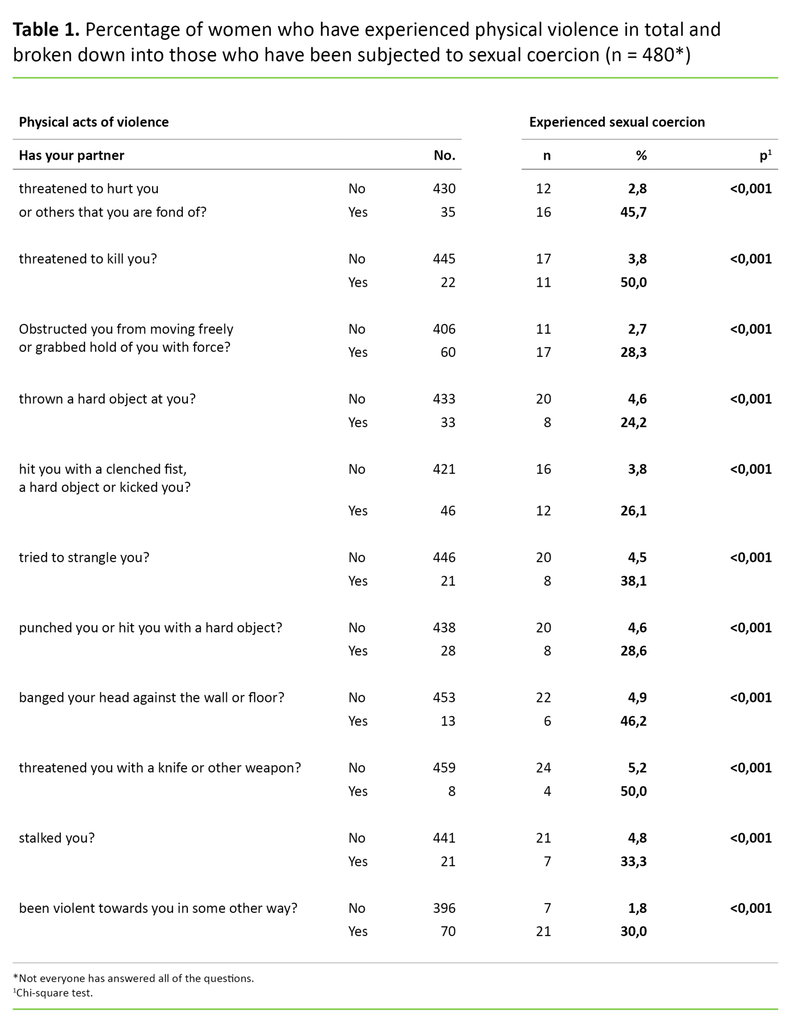
In order to map psychological violence, we used the Psychological Maltreatment of Women Inventory (PMWI), an instrument developed and validated by Tolman (18) and translated and used in an earlier Norwegian survey (19). The questions are divided into two categories: ‘acts of dominance and isolation’ (Table 2) and ‘emotional and verbal abuse’ (Table 3). Each question has five response options: ‘never’, ‘seldom’, ‘occasionally’, ‘often’ and ‘very often’. In our study, the response options ‘often’ and ‘very often’ were merged.
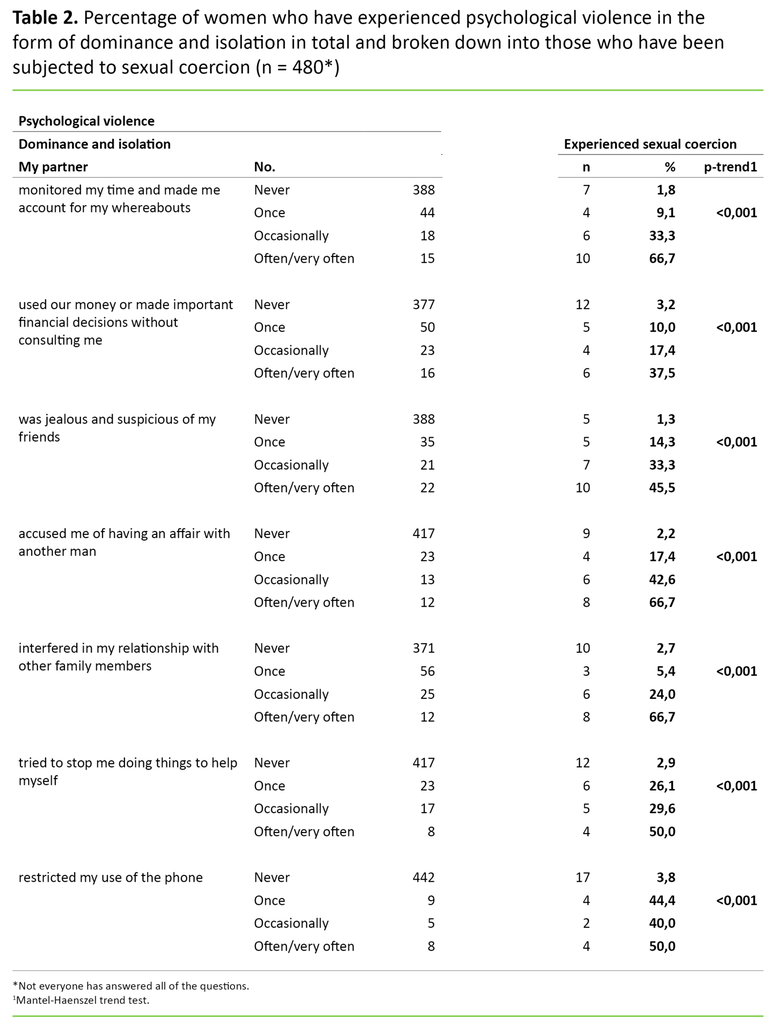
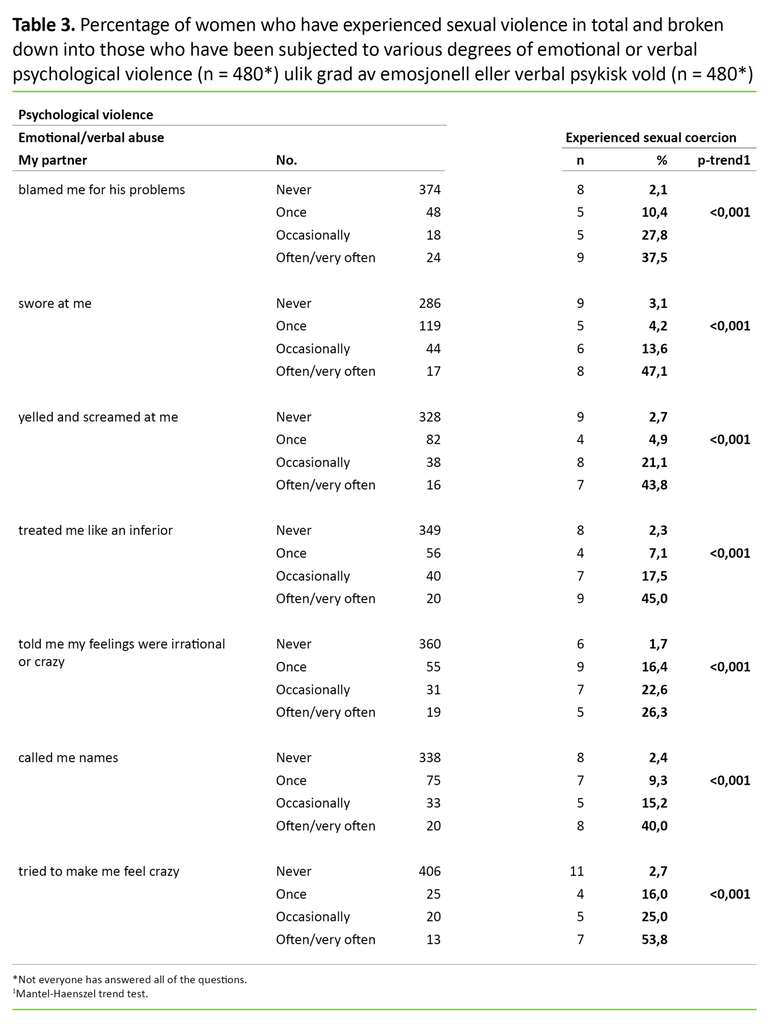
The questions about actions by a partner that make it difficult to stay in gainful employment (Table 4) are based on earlier studies of how violence in close relationships impacts on the working lives of women who are subjected to intimate partner violence (16, 17). Each of the questions could be answered with ‘never’, ‘sometimes’, ‘often’ or ‘very often’. Here too, ‘often’ and ‘very often’ were merged in the analyses.
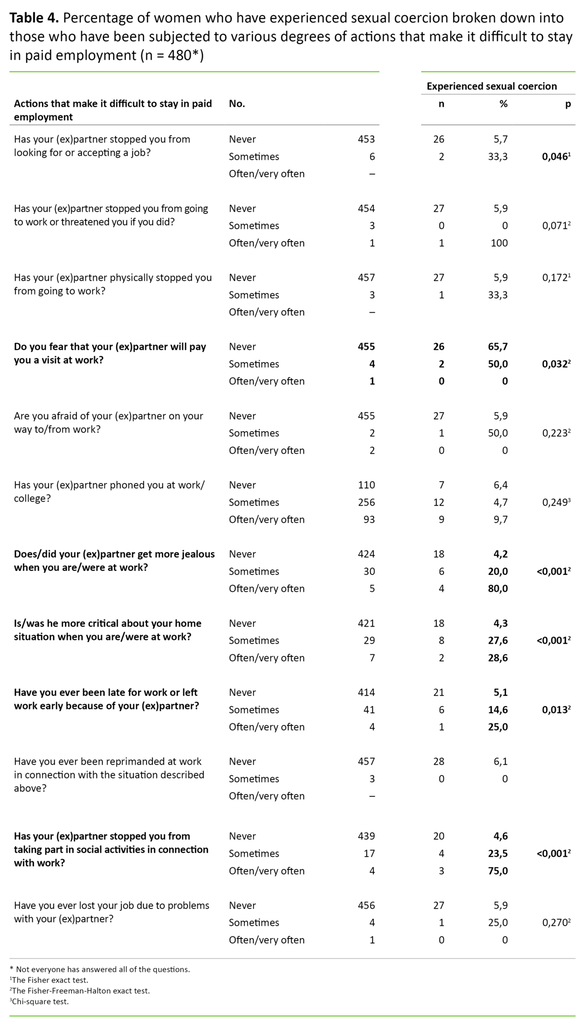
We sent out the questionnaire both in Norwegian and English in order to be able to include non-Norwegian speakers.
Analysis
The incidence of sexual coercion in the different categories of violence is shown as absolute numbers and percentages. Possible associations between sexual coercion and other types of partner violence were tested using the chi-square method. For groups with small sample sizes, we used the Fisher or Fisher-Freeman-Halton exact test. To test whether an increased level of violence is associated with a higher incidence of sexual coercion, we used the Mantel-Haenszel trend test.
T-tests and chi-square tests were used to establish whether background variables were evenly distributed among the women who had and had not been subjected to sexual coercion. Significance levels were set at p <0.05, and all of the analyses were performed in IBM SPSS Statistics 22.
Ethical considerations
Participation was voluntary and anonymised, and was in line with the Declaration of Helsinki. Participants’ safety was paramount, and in line with the ethical guidelines of the World Health Organization (WHO).
The study is approved by the Regional Committees for Medical and Health Research Ethics (REC) (ref. no. 2009/2591). REC granted permission for us to only include women, since a population sample that also included men would have required a significantly larger sample and thus incurred very high costs.
Special challenges
The first page of the questionnaire contained the telephone number of the researcher (first author) so that participants could call if they wanted to talk to the researcher. This opportunity to talk to the researcher was given in an attempt to increase the response rate, which is generally low in such surveys. The letter of information stated that participation was voluntary.
Results
In the random sample of 1500 women between the ages of 18 and 70, 527 answered the questionnaire. Of these, 480 were living with or had lived with a partner and were included in the study. The mean age was 44.8 years. A total of 5.8 per cent of the women in the population sample reported having been subjected to sexual coercion by a partner.
There were no significant differences in age, education, labour force participation, nationality or number of children among the women who had or who had not been subjected to sexual coercion.
All actions in the ‘physical violence’ category were significantly associated with sexual coercion (p <0.001). Among those who had received death threats from a partner or had been threatened with a knife or other weapon by a partner, 50 per cent had also experienced sexual coercion. One-third of those who had been stalked (33.3 per cent), or whose partner had tried to strangle them (38.1 per cent) or had been subjected to other violent behaviour (31.5 per cent) by a partner had also experienced sexual coercion. Among those who had been subjected to life-threatening violence by a partner, such as their head being banged against the floor, 46.2 per cent reported sexual coercion by a partner (Table 1).
All actions in the ‘psychological violence’ category were significantly associated with sexual coercion (p <0.001). There was also a significant trend showing the more often women had experienced various acts of dominance and isolation or emotional and verbal abuse, the more likely they were to be subjected to sexual coercion (Tables 2 and 3). Among those whose partner had often or very often tried to make them believe they were insane, 53.8 per cent had experienced sexual coercion. All of the women who had been subjected to sexual violence had experienced one or more acts of psychological or physical violence.
Six of the twelve questions about actions by a partner that make it difficult to stay in paid employment were significantly associated with sexual coercion. Among those who were often or very often late for work or had to leave work early, 25 per cent reported sexual coercion, while this was the case for 75 per cent of those who often or very often were unable to participate in social activities in connection with work (Table 4).
Discussion
This study shows that sexual coercion does not happen in isolation, but within a pattern of violence in marriage or cohabiting relationships. At the same time, it is important to point out that most people exposed to psychological and physical violence by a partner do not report sexual coercion. However, we see that when sexual violence occurs, half of the women receive death threats from their partner and one-third report serious physical violence, such as strangulation.
All acts involving psychological violence, such as dominance or control and emotional or verbal abuse are associated with sexual coercion. Thus, sexual coercion in marriage or cohabitating relationships represents a type of violence that is difficult to define as episodic violence (20). Episodic violence refers to situational anger in equal relationships.
Sexual coercion, as reported in this study, is classified as what Johnsen (20) terms ‘intimate terrorism’. Intimate terrorism occurs where one party is systematically violent and controlling. Systematic violence means that many different types of violence occur in parallel and that actions are repeated. Insecurity is therefore a major feature in the lives of victims of violence. Violent acts that are part of a recurring pattern over time have a major impact on the health of the victims. Documentation of various types of acts of violence is vital in the context of criminal justice (21).
Sexual coercion makes it difficult to hold down a job
Our study shows that sexual coercion is associated with actions that make it difficult to stay in paid employment. For example, the partner prevents the woman from getting to work on time or repeatedly fails to collect their children from nursery. They do not let the woman participate in social activities at work and become more and more jealous and critical. Sexual coercion is also associated with fear that the partner will pay a visit to the woman at work. Actions that make it difficult for women to stay in paid employment are a type of psychological violence that is also termed ‘economic violence’.
The correlation between intimate partner violence and difficulties staying in paid employment is not well documented in previous studies, and the findings of this study are therefore important. Being unemployed can have far-reaching consequences for women’s opportunities for an independent life (22). Income throughout working life impacts on pensions, credit rating and activities in society as well as the experience of being recognised as an independent subject (16).
Isolation from friends as well as control of money and appearance are also associated with sexual violence by a husband or cohabitant in the study by Basile (24). The study suggests that sexual violence in marriage and cohabiting relationships is linked to the partner’s need for power and control.
Physical violence is associated with sexual coercion
In our study, all physical acts of violence are associated with sexual coercion. Very serious violence, such as threats using a knife or other weapon, was reported by half of those who had experienced sexual coercion. Sexual coercion is therefore often associated with other violence in marriage or cohabiting relationships, which implies a more serious pattern of violence. Such patterns of violence can have consequences in terms of health and criminal justice.
In a study of women at Norwegian refuge shelters (14), sexual coercion by a partner was associated with other serious physical and psychological violence, such as violence against pregnant women, dominance and isolation, as well as biting, hair pulling and twisting of the arm (14). Sexual coercion occurs in conjunction with many other types of violence and very serious violence, including in our population sample.
Our study is a cross-sectional study that does not examine causality or whether other violence occurs before or after sexual violence. However, other studies show that sexual coercion can take place after other forms of psychological or physical violence (23, 24). Women describe how the man wants sex after an episode of violence, as a comfort when he regrets his actions and wants reconciliation, and as an escape from the disturbing fact that he has subjected his spouse or cohabitant to serious acts of violence.
Women who experience violence also report that they believe the men enjoy this kind of sex, despite the women being coerced into it (23). Whether the sexual acts can be defined as coercion, i.e. they did not take place voluntarily, is also a key issue in the legal treatment of rape cases. In such cases, it is often the credibility of the victim versus that of the defendant that becomes the determining factor. Healthcare personnel’s records and mapping, as well as forensic medicine documentation of psychological and physical violence will increase the victim’s credibility (21).
Our study shows that none of those who have experienced sexual coercion have evaded other forms of dominance and isolation, emotional and verbal abuse or physical violence. This fact emphasises the importance of health professionals’ mapping of different types of violence when dealing with women exposed to such behaviour.
Sexual violence is kept hidden
Sexual coercion in marriage or cohabiting relationships is often hidden, and the woman will seldom use the word ‘rape’ or ‘violence’, or even ‘coercion’. According to WHO, there are norms that support violence against women, such as that a man has a right to assert power over a woman, and that sexual activity (including rape) is a marker of masculinity (27).
When sexual coercion occurs within marriage or cohabiting relationships, the acts are often not defined as rape or abuse, either by the victim or society in general, even though the law is clear on this point. This may be due to the fact that, historically, women are often conditioned to think that a husband or cohabitant is entitled to have sex whenever they wish (23, 24).
Strengths and weaknesses of the study
The response rate in our study is too low for the incidence of 5.8 per cent of sexual coercion among women to be generalised as applying to the population of women in Norway as a whole. However, Norwegian population surveys, which pose the same questions about sexual coercion, report a similar occurrence (5, 13). A low response rate is less significant in studies examining associations between different variables.
Low response rates are not uncommon in studies of taboo subjects. Women exposed to the most serious violence rarely respond to surveys as they are afraid of reprisals by their partner. Violence in close relationships is usually hidden in our society and is associated with shame. The victims are often told that no one must know what is happening behind the four walls of their home.
The private sphere is also traditionally regarded as something that should not be revealed if it puts the family in a bad light. If the victim speaks out about the violence, the perpetrator also loses some of their control. The experience of losing control increases the risk of violence. One study shows that the more serious the violence that women had been exposed to, the less often they would respond to questionnaires, even when the man was in a separate room, but nearby (25). The low response rate means that the study results must be interpreted with caution.
The strengths of the study are that the questions have previously been asked and validated and that the sample is random.
Implications for practice
Knowledge that sexual coercion occurs in conjunction with other intimate partner violence will have implications for nursing approaches to the victims of violence and in the work of detection or mapping, risk assessment, safety planning and forensic medicine documentation. If a woman says that her husband refuses to let her study or work, it is important to ask if there are other ways he controls and asserts his power over her.
Minor injuries like bruising, swelling and grazes can also be due to intimate partner violence. It is therefore important that nurses know the best way to identify partner violence. Knowledge of the correlation between psychological and physical violence and actions that make it difficult to stay in paid employment means that nurses must ask questions that include all forms of partner violence. Likewise, identifying sexual coercion will trigger questions about other partner violence.
In order for the women to feel taken care of, the way that healthcare personnel ask questions and the surrounding framework are essential elements (26, 27). Safety planning and risk assessment, as well as secure and accurate record keeping, are also vital in the context of forensic medicine (27, 28).
In forensic medicine documentation and in connection with applications for victim compensation, records and other documentation in the form of photos and evidence are of great importance. Although the forensic medicine declarations are mainly written by doctors in Norway, nurses can help to identify violence in close relationships and to ensure that it is communicated to the doctor and referral centre where relevant, which have good expertise in forensic medicine documentation (29).
Nurses’ knowledge of their own duties, such as the duty to notify versus confidentiality, and knowledge of relevant support agencies, such as refuge shelters and Alternative to Violence, is important in reducing the health risk to the victim. Most victims of sexual and other violence by a partner need medical care and help to establish a life free from violence.
Conclusion
Sexual coercion by husbands or cohabitants against women occurs together with psychological and physical violence. Sexual coercion also occurs in conjunction with actions that make it difficult for the women to stay in paid employment.
References
1. NOU 2008:4. Fra ord til handling. Bekjempelse av voldtekt krever handling. Oslo: Justis- og politidepartementet; 2008. Available at: https://www.regjeringen.no/no/dokumenter/nou-2008-4/id497659/(downloaded 16.08.2017).
2. Logan TK, Walker R, Cole J. Silenced suffering: The need for a better understanding of partner sexual violence. Trauma Violence & Abuse. 2015;16:111–35.
3. Lov 1. oktober 2015 om straff (straffeloven). Available at: https://lovdata.no/dokument/NL/lov/2005-05-20-28(downloaded 16.08.2017).
4. Folkehelseinstituttet. Folkehelserapporten 2014. Helsetilstanden i Norge. Oslo: rapport 2014:4. Available at: https://www.fhi.no/globalassets/dokumenterfiler/rapporter/folkehelserapporten-2014-pdf.pdf(downloaded 09.04.2018).
5. Schei B, Haaland T, Clausen S-E. Vold mot kvinner i Norge. In: Haaland T, Clausen S-E, Schei B, eds. Vold i parforhold. NIBR-rapport 2005:3. Oslo: Norsk institutt for by- og regionforskning; 2005.
6. Meld. St. nr. 15 (2012–2013). Forebygging og bekjempelse av vold i nære relasjoner. Available at: https://www.regjeringen.no/no/dokumenter/meld-st-15-20122013/id716442/sec1(downloaded 16.08.2017).
7. Krug EG, Dahlberg LL, Mercy JA, Zwi AB, Lozano R, eds. World report on violence and health. Genève: WHO; 2002.
8. Campbell JC. Health consequences of intimate partner violence. Lancet. 2002;359:1331–6.
9. Bonomi AE, Thompson RS, Anderson M, Reid RJ, Carrell D, Dimer JA, et al. Intimate partner violence and women's physical, mental, and social functioning. Am J Prev Med. 2006;30:458–66.
10. Eberhard-Gran M, Schei B, Eskild A. Somatic symptoms and diseases are more common in women exposed to violence. J Gen Intern Med. 2007;22:1668–73.
11. Spedding R, McWilliams M, McNicholl B, Dearden C. Markers for domestic violence in women. J Accid Emerg Med. 1999;16:400–2.
12. Campbell JC, Alford P. The dark consequences of marital rape. Am J Nurs. 1989;89:946–9.
13. Thoresen S, Hjemdal OK. Vold og voldtekt i Norge. En nasjonal forekomststudie av vold i et livsløpsperspektiv. Oslo: Nasjonalt kunnskapssenter om vold og traumatisk stress; 2014.
14. Alsaker K, Morken T, Baste V, Campos-Serna J, Moen BE. Sexual assault and other types of violence in intimate partner relationships. Acta Obstet Gynecol Scand. 2012;91:301–7.
15. Howard L, Feder G, Agnew-Davies R. Domestic violence and mental health. London: Royal College of Psychiatrists; 2013.
16. Alsaker K, Moe BE, Baste V, Morken T. Vold i parforhold kan gjøre lønnsarbeid vanskelig. Tidsskrift for kjønnsforskning. 2014;38:270–86.
17. Alsaker K, Moen B, Baste V, Morken T. How has living with intimate partner violence affected the work situation? A qualitative study among abused women in Norway. Journal of Family Violence. 2016;31:479–87.
18. Tolman R. The validation of the psychological maltreatment of women inventory. Violence Vict. 1999;14:25–37.
19. Alsaker K. Quality of life among women who have experienced intimate partner violence: a one year follow-up study among women at Norwegian women's shelter. (Doktoravhandling.) Bergen: Universitetet i Bergen; 2008.
20. Johnson MP. Patriarchal terrorism and common couple violence; Two forms of violence against women. J Marriage Fam. 1995;57:283–94.
21. Aas G. Politi- og påtalemyndighetens praktisering av familievoldsbestemmelsen (jf. straffelovens §219). Tidsskrift for strafferett. 2013;13:236–45.
22. Gilroy H, Symes L, McFarlane J. Economic solvency in the context of violence against women: a concept analysis. Health & Social care in the community. 2014;23:97–106.
23. Råkil M, ed. Menns vold mot kvinner. Behandlingserfaringer og kunnskapsstatus. Oslo: Universitetsforlaget; 2002.
24. Basile KC. Histories of violent victimization among women who reported unwanted sex in marriages and intimate relationships findings from a qualitative study. Violence Against Women. 2008;14:29–52.
25. Waltermaurer EM, Ortega CA, McNutt LA. Issues in estimating the prevalence of intimate partner violence. J Interpers Violence. 2003;18:959–74.
26. WHO. Responding to intimate partner violence and sexual violence against women. WHO clinical and policy guidelines. Genève: WHO; 2013.
27. WHO. Understanding and addressing violence against women: Intimate partner violence. Genève: WHO; 2012.
28. McFarlane J, Malecha A, Gist J, Watson K, Batten E, Hall I, et al. An intervention to increase safety behaviors of abused women: results of a randomized clinical trial. Nurs Res. 2002;51:347–54.
29. Johnsen GE, Hunskår S, Zachariassen S, Alsaker K, Nesvold H. Overgrepsmottak 2017. Status etter spesialisthelsetjenestens ansvarsovertakelse. Bergen: Nasjonalt kompetansesenter for legevaktmedisin – Uni Research Helse; 2017.














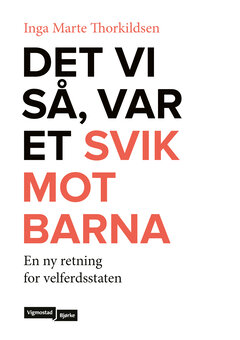
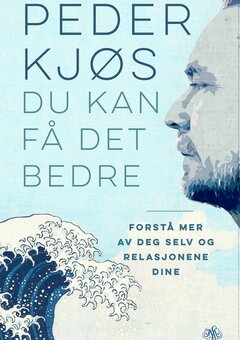
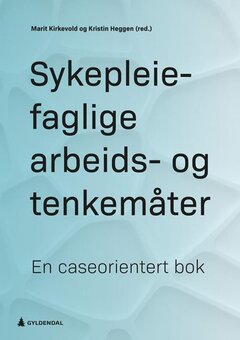



Comments